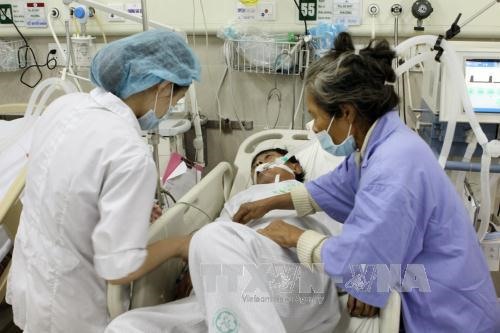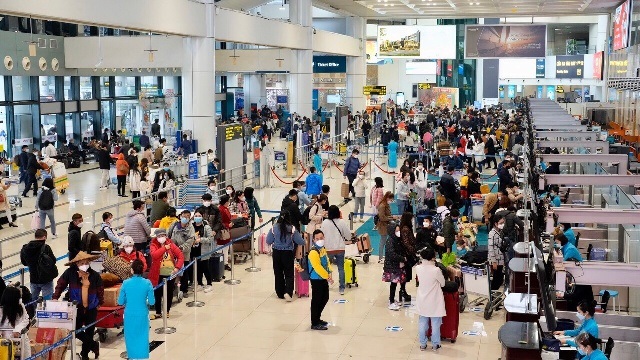.jpg) Society
Society

One morning last month 53-year-old Hà Nội resident Vũ Hữu woke up feeling weak over half of his body. He could barely grasp items with his hands and his legs felt like jelly.
 |
| Medical staff perform emergency treatment for a stroke patient at Bạch Mai Hospital in Hà Nội. — VNA/VNS Photo Dương Ngọc |
HÀ NỘI — One morning last month 53-year-old Hà Nội resident Vũ Hữu woke up feeling weak over half of his body. He could barely grasp items with his hands and his legs felt like jelly.
With a medical history of having diabetes and hypertension, he immediately went to Bạch Mai Hospital.
“Doctors said I had a light ischemic stroke due to a cerebral embolism,” Hữu said. He recovered shortly after receiving treatment.
Hữu’s timely reactions saved his life. But several stroke patients were only taken to hospitals when complications – like paralysis – have occurred, or after they have fallen into a coma due to insufficient knowledge on stroke symptoms, according to Prof Dr Lê Văn Thính, dean of the neurology department at Bạch Mai Hospital.
Some 200,000 Vietnamese citizens suffer strokes each year, according to the Việt Nam Stroke Association. Half of them die; another 30 per cent are at high risk of paralysis.
Stroke is the third leading cause of death in the country behind heart-related diseases and cancer, and had the highest disability rate, according to the association.
A stroke is a medical emergency that occurs when blood vessels in the brain are blocked or ruptured, interrupting the blood supply to the brain and causing brain cells to die within minutes. Clinical symptoms of stroke include hemiplegia (paralysis on one side of the body), incoherent speech or patients falling into coma.
As the number of stroke patients increased over recent years, the Ministry of Health (MoH) last year issued Circular No. 47 to regulate stroke examinations and treatment at medical units nationwide, which takes effect from today.
Depending on their capability, one of the following stroke response task forces must be formed at each and every medical unit: stroke team, stroke unit, stroke department or stroke centre, said Lương Ngọc Khuê, director of MoH’s healthcare management department. They must operate 24 hours a day and 7 days a week to ensure timely treatment for stroke patients and reduce sequelae of cerebral strokes, he said.
Doctors at the HCM City Medicine and Pharmacy University recently succeeded in saving a stroke patient’s life thanks to the hospital’s stroke alert process.
At home, the 42-year-old patient suddenly found it difficult to speak. His face and mouth became distorted, the left half of his body paralysed.
The hospital’s stroke alert system was initiated right after the patient was hospitalised with the involvement of the majority of doctors at the emergency department, the neurology department’s stroke unit, the diagnostic imaging department and a crew of cerebrovascular intervention doctors.
An emergency CT scan showed that the patient had had a brainstem infarction due to an occlusion of the basilar artery. His family said it had been his habit in the last 10 years to smoke 1.5-2 packs of cigarettes per day.
Process improvement
The treatment process for cases of acute cerebral infarction had been improved by the cerebrovascular pathology department of the People’s Hospital 115 in HCM City in order to save time for patients, said Nguyễn Đình Phú, vice director of the hospital.
The duration of the intravascular interventional treatment phase had been shortened, enabling doctors to enter the decision making phase earlier, he said.
Specifically, contacts of vascular intervention doctors are included in their online duty schedule so that they could be reached anytime, even at midnight. Administrative and financial procedures are processed quickly. Advance payments can be made by the hospital to cover patients’ medical fees.
In addition, consultations between leaders of departments can be done via smartphone applications. Diagnosing images can also be transferred via smartphones.
The shortened process would improve neurological rehabilitation after 3 months of treatment for cerebral infarction patients, Phú said.
The hospital would continue to improve the process by increasing collaboration between the emergency, diagnostic imaging and clinical laboratory departments, he added. It would focus on shortening the duration of the blood collection and process phases in preparation for interventional treatment, he said. — VNS


.jpg)





.jpg)
